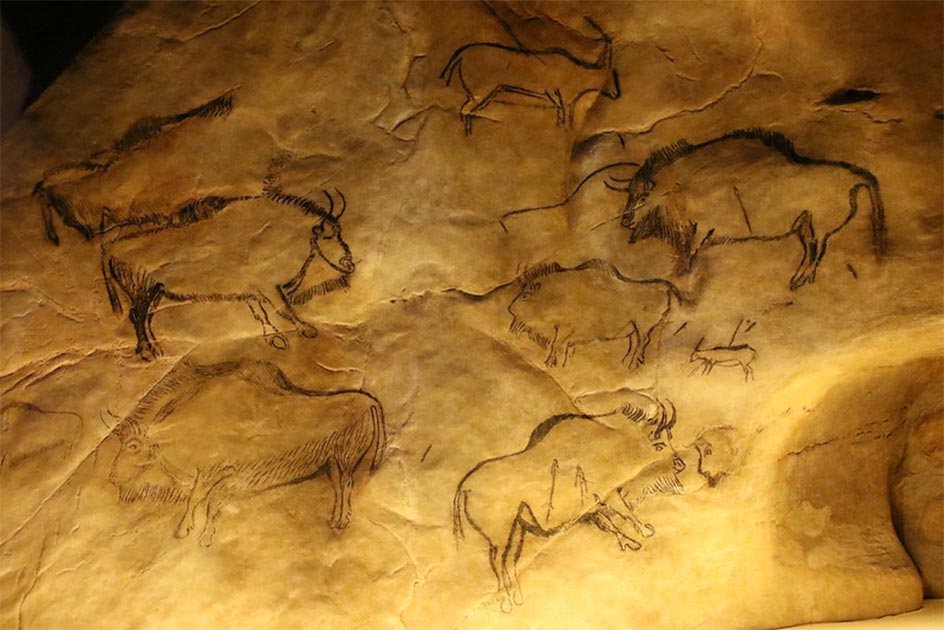Follow Ancient Footsteps to the Famous Rock Art of Niaux Cave
France is famous for its beautiful scenery, historic cities, and of course, wine. The country also has many spectacular cave systems such as the Bournillon Cave which has the highest cave opening in Europe at 1371 feet (418 m) high; the Jean-Bernard which is one of the deepest caves in the world; and the famous Niaux Cave, which contains some of the finest examples of prehistoric artworks. Niaux Cave is also the largest one open to the public in Europe.
Origins of the Niaux Cave
The Niaux caves is part of the Pyrenees mountain range and is millions of years old. It was created over eons by chemical processes, water erosion, and tectonic forces. The Karst System in this region took its current form in the last Ice Age.
The cave was ideal for birds and animals such as auks and goats, especially during the last Ice Age and many remains of extinct creatures such as the auroch have been found in Niaux. It also attracted some of the first Europeans and 500 of their footprints remain to this day.

Illustration of the now extinct auroch ( public domain )
The hunter-gatherers who occupied the cave may have used the depths for religious or cultural purposes. The prehistoric art discovered along the passageways is among the most significant ever found and the extensive rock art galleries have enabled researchers to understand more of our ancient ancestors. These ancient images would possibly have been considered as magical and used in ceremonies.
Niaux cave has been explored since the 17 th century and many explorers have left their graffiti on the walls of the cave, the earliest of which dates back to 1602. It was only in the early twentieth century that the caves were protected by the French government after it was proven that one panel of rock art, the famous Salon Noir, was over 10,000 years old.
- Ten Mysterious Examples of Rock Art from the Ancient World
- 15,000-Year-Old Paleolithic Rock Art Gallery Identified On Russian Border
- How Our Ancestors with Autistic Traits Led a Revolution in Ice Age Art

Some of the many animals that would have been found around the Niaux Cave (Fabrega, J.J / CC BY-NC-SA 2.0)
In 1925 the Cartailhac Gallery was discovered by a team of researchers led by J. Mandeman and in the 1970s and 1980s, a full inventory of the rock art was completed. As part of the efforts to conserve the cave art, some lakes were drained in the 2000s.
The Prehistoric Paintings at Niaux Caves, France
Archaeologists and other specialists believe that the rock art founds in the caverns dates from the Magdalenian period and the art is believed to be between 10,000 and 17,000 years old. A number of panels contain images drawn in black out-line with a ‘spray-paint’ technique used to color the animals. The images represent bison, goats, ibex, horses, and others that were once native to Europe in the aftermath of the last Ice Age.
The majority of the rock art is located in the passageway known as the Salon Noir. They were drawn in profile, and each one appears to float on the cave walls. The incisions and cuts in the caves may represent animal footprints. These precious images are now kept in an artificial environment to preserve them for future generations.
Stalactites, Rock Art and More to be Seen at Niaux Caves
The cave is located in the south of France and is part of an extensive cave system that includes the Sabart Cave. The system is complex and almost 9 miles long (14.1 km). Most of the caverns are easily accessible as the cave entrance is high.

The weasel of Naiux, executed in 10 bold, faultless strokes made by an experienced artist (Fabrega, J.J / CC BY-NC-SA 2.0)
Many stalactites and stalagmites grace the numerous chambers and passageways lead deeper into the system. Sadly, stalactites were stolen in the 19 th century by souvenir hunters. There are also several pools and underground lakes in the Niaux cave system, and the climate of the cavern is much cooler than the environment outside, approximately that of the Late Ice Age.
Although there are numerous high chambers, many of the caverns are narrow and impassable. Niaux’s famous prehistoric rock art is concentrated in passageways that are deep in the system.
How to visit Niaux Caves, France
The cave system is 15 minutes away from the picturesque town of Tarascon-sur-Ariège. The labyrinth of caves is near a prehistoric archaeological park where there are many exhibitions relating to Niaux. Because numbers are limited to conserve the popular site, it is necessary to book ahead for a tour of the caves which lasts up to an hour and a half. The floors of the system are wet so great care should be taken. There are also several other interesting caves in the vicinity.
Top image: Rendering of bison in Niaux Cave Source: Valette, C / CC BY ND 2.0
By Ed Whelan
References
Bakalowicz, M., Sorriaux, P., & Ford, D. C. (1984). Quaternary glacial events in the Pyrenees from U-series dating of speleothems in the Niaux-Lombrives-Sabart caves, Ariège, France. Norsk Geografisk Tidsskrift-Norwegian Journal of Geography, 38(3-4), 193-197
Available at: https://www.tandfonline.com/doi/abs/10.1080/00291958408552125
Clottes, J., Menu, M., & Walter, P. (1990). New light on the Niaux paintings. Rock Art Research, 7(1), 21-26
Available at: https://www.bcin.ca/bcin/detail.app?id=110376&wbdisable=true
Clottes, J. (2008). Cave art (p. 352). London: Phaidon
Available at: https://www.bcin.ca/bcin/detail.app?id=110376&wbdisable=true



















